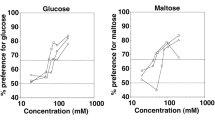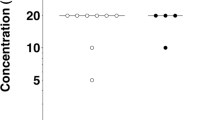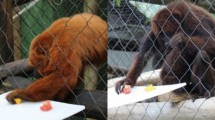Abstract
Nonhuman primates differ widely in various aspects of their ecology and are thus particularly suitable for studying the mechanisms underlying interspecies differences in taste perception. Therefore, we assessed taste preference thresholds as well as relative preferences for five food-associated sugars in three adult black-and-white ruffed lemurs (Varecia variegata variegata) using two-bottle choice tests of brief duration (1 min). We found that the subjects significantly preferred concentrations as low as 25 mM sucrose and fructose, and 50 mM glucose, maltose, and lactose over tap water. When given a choice between all binary combinations of the same five saccharides presented at equimolar concentrations of 50, 100, and 200 mM, respectively, the subjects displayed marked preferences for individual sugars in the following order: sucrose > fructose > glucose ≥ maltose ≥ lactose. The sensitivity of the black-and-white ruffed lemurs to the five saccharides falls into the same range as that reported in other primates. The pattern of relative preferences for food-associated sugars was found to be largely similar to that reported in platyrrhine primates and in human subjects, but differed from that reported in a catarrhine primate. Taken together, the results of the present study support the notions that the taste sensitivity in primates for food-associated sugars may correlate with phylogenetic relatedness, with body mass, and with lactose content in milk. Further, the results support the notion that relative preferences for food-associated sugars in primates, but not necessarily their sweet-taste sensitivity, may correlate with dietary specialization.



Similar content being viewed by others
References
Beck, E., & Ziegler, P. (1989). Biosynthesis and degradation of starch in higher plants. Annual Review of Plant Physiology, 40, 95–117.
Breslin, P. A. S., Beauchamp, G. K., & Pugh, E. N. (1996). Monogeusia for fructose, glucose, sucrose, and maltose. Perception & Psychophysics, 58, 327–341.
Britt, A. (2000). Diet and feeding behaviour of the black-and-white ruffed lemur (Varecia variegata variegata) in the Betampona Reserve, Eastern Madagascar. Folia Primatologica, 71, 133–141.
Curtis, D. J. (2004). Diet and nutrition in wild mongoose lemurs (Eulemur mongoz) and their implications for the evolution of female dominance and small group size of lemurs. American Journal of Physical Anthropology, 124, 234–247.
Glaser, D. (1986). Geschmacksforschung bei Primaten. Vierteljahresschrift der Naturforschenden Gesellschaft Zürich, 131, 92–110.
Glaser, D., Hellekant, G., Brouwer, J. N., & van der Wel, H. (1978). The taste responses in primates to the proteins thaumatin and monellin and their phylogentic implications. Folia Primatologica, 29, 56–63.
Glaser, D., Tinti, J. M., & Nofre, C. (1995). Evolution of the sweetness receptor in primates. I. Why does alitame taste sweet in all prosimians and simians, and aspartame only in Old World simians? Chemical Senses, 20, 573–584.
Glaser, D., Tinti, J. M., & Nofre, C. (1996). Gustatory responses of non-human primates to dipeptide derivatives or analogues, sweet in man. Food Chemistry, 56, 313–321.
Glaser, D., van der Wel, H., Brouwer, J. N., Dubois, G. E., & Hellekant, G. (1992). Gustatory responses in primates to the sweetener aspartame and their phylogenetic implications. Chemical Senses, 17, 325–335.
Hinde, K., & Milligan, L. A. (2011). Primate milk: Proximate mechanisms and ultimate perspectives. Evolutionary Anthropology, 20, 9–23.
Hladik, C. M. (1979). Diet and ecology of prosimians. In G. A. Doyle & R. D. Martin (Eds.), The study of prosimian behavior (pp. 307–357). New York: Academic Press.
Jiang, P., Josue, J., Li, X., Glaser, D., Li, W., Brand, J. G., Margolskee, R. F., Reed, D. R., & Beauchamp, G. K. (2012). Major taste loss in carnivorous mammals. Proceedings of the National Academy of Sciences of the USA, 109, 4956–4961.
Junge, R. E., Williams, C. V., & Campbell, J. (2009). Nutrition and behavior of lemurs. Veterinary Clinics of North America (Exotic Animals), 12, 339–348.
Kinghorn, A. D., & Soejarto, D. D. (1986). Sweetening agents of plant origin. Critical Reviews in Plant Science, 4, 79–120.
Laska, M. (1996). Taste preference thresholds for food-associated sugars in the squirrel monkey (Saimiri sciureus). Primates, 37, 91–95.
Laska, M. (1997). Taste preferences for five food-associated sugars in the squirrel monkey (Saimiri sciureus). Journal of Chemical Ecology, 23, 659–672.
Laska, M. (2000). Gustatory responsiveness to food-associated sugars and acids in pigtail macaques Macaca nemestrina. Physiology & Behavior, 70, 495–504.
Laska, M., Carrera Sanchez, E., & Rodriguez Luna, E. (1998). Relative taste preferences for food-associated sugars in the spider monkey (Ateles geoffroyi). Primates, 39, 91–96.
Laska, M., Carrera Sanchez, E., Rodriguez Rivera, J. A., & Rodriguez Luna, E. (1996). Gustatory thresholds for food-associated sugars in the spider monkey (Ateles geoffroyi). American Journal of Primatology, 39, 189–193.
Laska, M., Kohlmann, S., Scheuber, H. P., Hernandez Salazar, L. T., & Rodriguez Luna, E. (2001). Gustatory responsiveness to polycose in four species of nonhuman primates. Journal of Chemical Ecology, 27, 1997–2011.
Laska, M., Schüll, E., & Scheuber, H. P. (1999). Taste preference thresholds for food-associated sugars in baboons, Papio hamadryas anubis. International Journal of Primatology, 20, 25–34.
Li, X., Bachmanov, A. A., Maehashi, K., Li, W., Lim, R., Brand, J. G., Beauchamp, G. K., Reed, D. R., Thai, C., & Floriano, W. B. (2011). Sweet taste receptor gene variation and aspartame taste in primates and other species. Chemical Senses, 36, 453–475.
Liman, E. R. (2006). Use it or lose it: Molecular evolution of sensory signaling in primates. European Journal of Physiology, 453, 125–131.
Nagy, S., & Shaw, P. E. (1980). Tropical and subtropical fruits: Composition, nutritive values, properties and uses. Westport CT: Avi Publishing.
Nofre, C., Tinti, J. M., & Glaser, D. (1996). Evolution of the sweetness receptor. II. Gustatory responses of non-human primates to nine compounds known to be sweet in man. Chemical Senses, 21, 747–762.
Pfaffmann, C., Bartoshuk, L. M., & McBurney, D. H. (1971). Taste psychophysics. In H. Autrum, L. Beidler, & T. Acree (Eds.), Handbook of sensory physiology (Part 2, Vol. 4, pp. 75–101). Berlin: Springer-Verlag.
Plata-Salaman, C. R., Scott, T. R., & Smith-Swintosky, V. L. (1993). Gustatory neural coding in the monkey cortex: The quality of sweetness. Journal of Neurophysiology, 69, 482–493.
Ramirez, I. (1990). Why do sugars taste good? Neuroscience and Biobehavioral Reviews, 14, 125–134.
Ratsimbazafy, J. (2006). Diet composition, foraging, and feeding behavior in relation to habitat disturbance: Implications for the adaptability of ruffed lemurs (Varecia v. editorium) in Manombo Forest, Madagascar. In L. Gould & M. L. Sauther (Eds.), Lemurs: Ecology and Adaptation (pp. 403–422). New York: Springer.
Richter, C. P., & Campbell, K. H. (1940). Taste thresholds and taste preferences of rats for five common sugars. Journal of Nutrition, 20, 31–46.
Schmidt, D. A., Iambana, R. B., Britt, A., Junge, R. E., Welch, C. R., Porton, I. J., & Kerley, M. S. (2010). Nutrient composition of plants consumed by black and white ruffed lemurs, Varecia variegata, in the Betampona Natural Reserve, Madagascar. Zoo Biology, 29, 375–396.
Sclafani, A. (2004). The sixth taste? Appetite, 43, 1–3.
Sclafani, A., & Mann, S. (1987). Carbohydrate taste preference in rats: glucose, sucrose, maltose, fructose and polycose compared. Physiology & Behavior, 40, 563–568.
Simmen, B. (1994). Taste discrimination and diet differentiation among New World primates. In D. J. Chivers & P. Langer (Eds.), The digestive system in mammals: Food, form, and function (pp. 150–165). Cambridge: Cambridge University Press.
Simmen, B., & Charlot, S. (2003). A comparison of taste thresholds for sweet and astringent-tasting compounds in great apes. Comptes Rendus Biologies, 326, 449–455.
Simmen, B., & Hladik, C. M. (1998). Sweet and bitter taste discrimination in primates: Scaling effects across species. Folia Primatologica, 69, 129–138.
Simmen, B., Josseaume, B., & Atramentowicz, M. (1999). Frugivory and taste responses to fructose and tannic acid in a prosimian primate and a didelphid marsupial. Journal of Chemical Ecology, 25, 331–346.
Smith, R. J., & Jungers, W. L. (1997). Body mass in comparative primatology. Journal of Human Evolution, 32, 523–559.
Spector, A. C. (2003). Psychophysical evaluation of taste function in nonhuman mammals. In R. L. Doty (Ed.), Handbook of olfaction and gustation (2nd ed., pp. 861–879). New York: Marcel Dekker.
Sunderland, G., & Sclafani, A. (1988). Taste preferences of squirrel monkeys and bonnet macaques for polycose, maltose, and sucrose. Physiology & Behavior, 43, 685–690.
van Gemert, L. J. (2011). Flavour thresholds: Compilations of flavour threshold values in water and other media (2nd ed.). Utrecht: Oliemans Punter & Partner.
White, C. R., & Seymour, R. S. (2003). Mammalian basal metabolic rate is proportional to body mass2/3. Proceedings of the National Academy of Sciences of the USA, 100, 4046–4049.
Yamashita, N. (2008). Chemical properties of the diets of two lemur species in Southwestern Madagascar. International Journal of Primatology, 29, 339–364.
Acknowledgments
The primate caretakers at Kolmården Wildlife Park are gratefully acknowledged for their support.
Author information
Authors and Affiliations
Corresponding author
Rights and permissions
About this article
Cite this article
Wielbass, A., Amundin, M. & Laska, M. Gustatory Responsiveness of Black-and-White Ruffed Lemurs (Varecia variegata variegata) to Food-Associated Sugars. Int J Primatol 36, 460–472 (2015). https://doi.org/10.1007/s10764-015-9835-3
Received:
Accepted:
Published:
Issue Date:
DOI: https://doi.org/10.1007/s10764-015-9835-3




